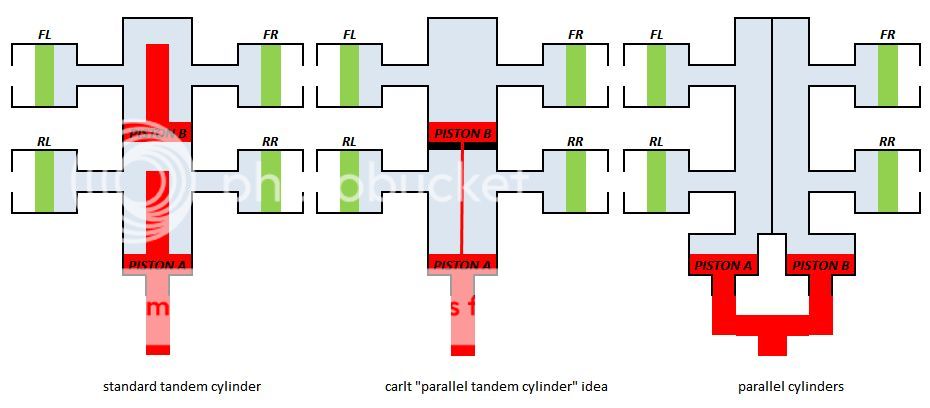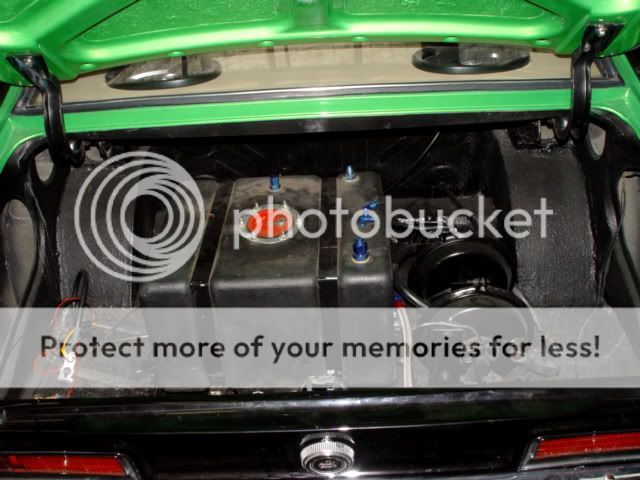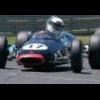Brake Master cylinders
#1

Posted 10 March 2013 - 23:56
Will fitting a tandem cylinder [of the same bore as the existing single cylinder] reduce pedal travel ?
my basic workings suggest that single piston displaces X volume with Y travel
tandem pistons displace 2 x X volume for Y travel , but as X cannot be increased then Y must be halved ?
Advertisement
#2

Posted 11 March 2013 - 00:20
Manufactures normally use a larger bore cylinder when installing a master vacc. Some older models used an inline booster on fronts only and rear were unassisted, usually drum rear. This actually is a very good idea as you get less ' compressability' of the pedal boosting only fronts. meaning a firmer pedal. Though modern ones usually work fairly well and seldom have these problems. Usually coupled with staggered bore master cylinders.
And bleeding can on occasion be a real drama.It should not be but often it is. Even just a simple flush the fluid through can cause problems.
The manufacturess seem to go out of their way to make something quite simple very sophisticated.
ABS brakes also often adds to these problems. I have worked on a couple of mainstream models that this is always a drama on, even when changing pads.
#3

Posted 11 March 2013 - 08:18
But I don't understand 'why' a tandem cylinder doesn't displace more fluid for a given bore/stroke ratio over a single piston
the primary piston displaces fluid to eg the front half the system , the secondary piston displaces fluid to the other, rear half the system
so each piston only has to displace half the given volume over a similar bore single piston cylinder for the given braking system
therefore half the piston stroke
?
Edited by carlt, 11 March 2013 - 08:18.
#4

Posted 11 March 2013 - 09:44
I understand the various ratios of leverage and hydraulics
But I don't understand 'why' a tandem cylinder doesn't displace more fluid for a given bore/stroke ratio over a single piston
the primary piston displaces fluid to eg the front half the system , the secondary piston displaces fluid to the other, rear half the system
so each piston only has to displace half the given volume over a similar bore single piston cylinder for the given braking system
therefore half the piston stroke
?
I would be inclined to agree - you would think that a tandem MC amounts to two separate MC's.
I have lost the rear brakes on a couple of occasions and kept the front discs - unless you are braking very hard it is difficult to notice any difference in the stopping power.
Which makes wonder - on a very light car (or motorcycle) do you need rear brakes at all? You see MotoGP riders braking hard with the rear wheel off the ground and the same with some lightweight racing Minis - so the rears don't do much. I have also seen advice from experienced 'bike racers to beginners in racing to never use the rear brake.
#5

Posted 11 March 2013 - 14:25
Edited by Bloggsworth, 11 March 2013 - 14:26.
#6

Posted 11 March 2013 - 18:11
the 'other' system I know as a dual circuit system with balance bar , as generally used in competition cars
If we use your diagram above - that is showing brakes on / pedal fully depressed.
Brakes off is pushrod back the length of green arrow / primary and secondary piston cup seals back to reservoir inlets .
So the stroke is the length of the green arrow - this stroke is required to displace enough fluid to operate the front and rear slave cylinders
Lets turn this cylinder into a single piston one - remove the primary piston and fit a longer pushrod that operates the secondary piston . blank off the primary inlet and outlet , tee the primary circuit into the secondary outlet - [a long winded hypothetical way of fitting a single piston master cylinder of the same bore]
So now when we depress the pushrod by the same stroke as the green arrow we are only moving the secondary piston , which is only going to displace the same amount of fluid as it did before , this is only enough to operate the rear slave cylinders -
For a single cylinder to displace the equivalent volume as your tandem cylinder above the single piston will have to move 2 X the green arrow
?
[edited to prevent a duel]
Edited by carlt, 11 March 2013 - 18:13.
#7

Posted 11 March 2013 - 20:31
having never had one apart I always assumed solid coupled -
so the primary circuit builds braking pressure before secondary piston can operate
cheers
#8

Posted 12 March 2013 - 10:59
can we be absolutely sure it is a seamless transmission from primary to secondary pistons though ?
#9

Posted 12 March 2013 - 11:45
can we be absolutely sure it is a seamless transmission from primary to secondary pistons though ?
Yes. The secondary piston is only there to allow one circuit to be pressurised if the other circuit leaks.
(Assuming the cylinder is the same bore in both sections) the pressure is the same both sides of the secondary piston UNLESS there is a leak in one of the circuits.
If there is a leak, then the pedal will travel until the mechanical travel is used up in whichever part section of the cylinder is connected to the leak and then the pressure increases in the other section.
#10

Posted 12 March 2013 - 23:25
exactly so -o.k. let's see if we can wrap it all together
- a standard tandem cylinder works in the way described, with the second piston being a "floating" separation piston to keep the two circuits separate,in case of fluid/pressure loss in one circuit.
- in practice it looks more like the one shown on the left
- the "extensions" are there to limit the possible "dead travel" of the pedal, as you don't want to run out of pedal travel (hitting the floor, bulkhead or pedal stop) if one circuit fails.
- if one circuit loses fluid, or the stiffness in the circuit reduces dramatically, due to boiling fluid, are aeration of the fluid, the piston "powering" this circuit, can only travel a set amount (dead travel - usually 1/2 of pedal travel), before it will hit it's stop, then the remaining pedal travel will/can be used to pressurize the still functioning circuit.
- now, what you have in mind carlt, I think looks like what I tried to sketch in the center.
The pedal would move both/two pistons simultaneously. Notice that I have drawn a wall, to separated the cylinder into two chambers. This avoids the problem described before, and allows both pistons to displace
fluid at the same time. It's possible to design/build such a system - no problem, but it's not what a "normal" tandem brake cylinder does.
If we look at it a bit more closely, you will notice something else. Now the pedal moves two pistons at the same time, displacing twice the fluid, as you envisioned/intended, but you have to keep one thing in mind.
P = F/A --> Pressure = Force / Area
As you now move two pistons at the same time, you have effectively doubled the area (* see below). If you still want to generate the same pressure, now you need twice the force to achieve this.
No free cheese here.
Yes with such a system, you would halve your pedal travel, but you "pay" for this with twice the force needed.
Technically, from a force vs. area vs. pressure point of view, your hypothetical system is the same as shown on the right, where you move two pistons at the same time via one pedal.
This is a "parallel" system as commonly used with a balance bar layout. You just tried to "package" it in line.
the reason this all started going round in my head was the single master cylinder system i am trying to get working a little better [too much travel and force needed]
with my assumption that the Tandem cylinder operated as per your middle diagram , I was hoping to fit a Tandem cylinder with smaller bore and not increase the travel
Anyway- the original system work ok[just] so is staying for the time being
#11

Posted 13 March 2013 - 01:19
If both travel and force are at the same time too large and the system is working more or less as designed with pad-rotor clearances within spec, I can't see any simple replumbing of the hydraulics being helpful for correcting that. Or am I missing something obvious?the reason this all started going round in my head was the single master cylinder system i am trying to get working a little better [too much travel and force needed]
#12

Posted 13 March 2013 - 10:15
my misconception for the Tandem cylinder and neglecting to always consider the system as a whole lead to the replumbing scenarioIf both travel and force are at the same time too large and the system is working more or less as designed with pad-rotor clearances within spec, I can't see any simple replumbing of the hydraulics being helpful for correcting that. Or am I missing something obvious?
[I wouldn't say the system was ever designed - more put together from parts off 3 different cars in the '70s]
the constraints of the footbox size ,by the engine position , make it virtually impossible to alter pedal position or ratio's
forgot to mention it is all drum brakes and Any shoe drag makes the car impossible to turn [on greasy mud/clay] hence the excess pedal travel
Edited by carlt, 13 March 2013 - 10:18.
#13

Posted 13 March 2013 - 13:43
Besides that, to reduce force and travel you need to increase effective piston area, which will only be achieved by schematics 2&3 from TC3000's image or a bigger master cylinder.
#14

Posted 13 March 2013 - 14:08
Isn't the basic twin circuits layout suposed to be FR+RL and FL+RR?
SAAB was advertising that as a safety feature unique to them in the seventies/eighties.
#15

Posted 13 March 2013 - 14:09
#16

Posted 13 March 2013 - 14:19
usually,Isn't the basic twin circuits layout suposed to be FR+RL and FL+RR?
Besides that, to reduce force and travel you need to increase effective piston area, which will only be achieved by schematics 2&3 from TC3000's image or a bigger master cylinder.
Front engine RWD = split Front and rear
FWD - split diagonally
larger Master cylinder = more force less travel
in my case the brake type on the hubs will need changing - but that's an off season job
#17

Posted 13 March 2013 - 15:16
can we be absolutely sure it is a seamless transmission from primary to secondary pistons though ?
My heart stopped when I saw those two words together. Luckily you're talking about something else entirely ...
#18

Posted 13 March 2013 - 15:56
#19

Posted 13 March 2013 - 16:29
larger Master cylinder = more force less travel
Ouch
Advertisement
#20

Posted 13 March 2013 - 17:12
the clutch pedal is set back towards the driver by 6-8" to allow clearance for the oil filter on the engine - the oil filter is very narrow [about the width of a sandwich plate take off for remote filter]
the brake pedal is mounted set back from throttle pedal so foot just touches brake pedal at WOT , hence a bit of a reach on long brake pedal travel . [there is not enough room to get foot on throttle past brake pedal [which itself is only 3/4" wide]
oh yeh - the steering column passes down in the foot box between clutch and brake [a suitable guide for the foot so it doesn't miss the brake pedal and get tangled in something else
its immensely fun to drive !
#21

Posted 13 March 2013 - 17:27
the only place for something that size would be in front of the radiator !for this reason, I proposed a remote booster setup.
As long as you have room for a MC, as you have now, it should be o.k.
Here is a principle schematic of such a setup
Was used on some Alfa Romeo road cars in the 60-70's, such as the round tail spider
might even struggle to squeeze it in there -
Edited by carlt, 13 March 2013 - 17:29.
#22

Posted 13 March 2013 - 18:31
Seems like your only option is to minimise the volume of fluid needed to achieve a certain braking result and then use a smaller diameter master cylinder. If everything in the system is as good as possible, ie perfectly round drums, linings bedded in, adjusters just so, best possible flexibles, perfectly bled, new fluid, master cylinder and seals set so they only just clear the reservoir port, almost zero pedal play.....the only place for something that size would be in front of the radiator !
might even struggle to squeeze it in there -
Servos cover a multitude of these little deficiencies and we are used to the way they isolate from brake feel. Recall that forty years or so ago many quite fast cars did without servos (but it was neccessary to keep right on top of brake maintenance.)
And have a strong leg.
#23

Posted 14 March 2013 - 08:45
the only place for something that size would be in front of the radiator !
might even struggle to squeeze it in there -
Interesting.
Just a couple of weeks ago I was peering around an Evante (sp?) and remarked to the owner my surprise that the booster/MC was ... beside the radiator. It was just about the only place for it in the engine bay.
#24

Posted 14 March 2013 - 18:42
http://www.google.co...LEYiO0AWDloGYAg
Made road legal and used for Classic Trialling
#25

Posted 14 March 2013 - 19:39
#26

Posted 14 March 2013 - 21:44
The car I am playing with ATM uses an 1" 1.2" bore master on the factory booster. Though that has big 4 spots front and large [front] single piston callipers rear on 13" rotors. With the adjustable proportioning valve. Though with that M/C it hardly needs it now.
When you start on this sort of stuff though buy yourself a flare tool and some bundy and practice first too!
For any motorport application inline residual valves that hold 3-5 lb will keep the pedal up. And really should be used with any drum rear set up or the pedal will always be crap. All factory drum brake set ups use one, sometimes as a seperate piece but often just as the seat in the side of the cylinder. These can fail and cause the pedal to get VERY firm and the brakes drag or conversly not hold pressure and have a crap pedal like without
For a race car though it is easier and these days quite cheap to buy a complete balance bar with cylinders, again Willwood etc make these
As for a tandem cylinder displacing more fluid, it will not for the same effort. Though I guess it has the capacity too.
#27

Posted 14 March 2013 - 21:48
Historic? It is a wheel tubbed LC Torana imitation drag car that is very WRONG. The tank is 250mm higher than the road car, the boosters!! are 12 feet from the front brakes. Always keep them close to the M/C, the closer the better and about 3 feet maximum.for this reason, I proposed a remote booster setup.
As long as you have room for a MC, as you have now, it should be o.k.
Here is a principle schematic of such a setup
Was used on some Alfa Romeo road cars in the 60-70's, such as the round tail spider
here you can see a historic car, with two boosters in the back trunk.
#28

Posted 15 March 2013 - 00:02
#29

Posted 15 March 2013 - 00:11
Having only glimpsed this since my first post if you do not wish to use a booster, or lack space make a brake pedal that reverses the leverage, eg above the fullcrum than the master can be mounted in the dash area.
all good stuff thanks - but the carbs are in the dash area !
there really is no more space
the passenger can only fit one leg in the footbox
I have a solution to the problem with a pedal re-mount/design , but it is not the 'quick fix' I was after - so closed season work
#30

Posted 16 March 2013 - 05:49
very boring for you big brains out there - but be kind to this mathless monkey.
Will fitting a tandem cylinder [of the same bore as the existing single cylinder] reduce pedal travel ?
my basic workings suggest that single piston displaces X volume with Y travel
tandem pistons displace 2 x X volume for Y travel , but as X cannot be increased then Y must be halved ?
Remember that the MC piston linear travel is not the same as the linear travel at the pedal face. It is a ratio. With a tandem MC, assuming the pistons have equal travel, the pedal will only require a linear travel of half as much to displace the same fluid volume. However, since the pedal force is being applied to twice the piston area, the resulting system pressure will only be half as great.
Manual hydraulic brake systems are essentially hydrostatic. This means that the force equilibrium in the system is simply P/A, disregarding any fluid effects and structural elasticities.
#31

Posted 16 March 2013 - 10:19
The way I express the situation in words is: assume the single cylinder pushrod travel is one inch for example (it may only be a couple of mm but it doesn't matter). The front piston (furthest from the pushrod) does actually move only half an inch - but as the rear piston acts on the front piston, while the rear piston is also moving forward half an inch - the front piston is moving away from the rear piston by half an inch - so the travel of the pushrod/rear piston is actually one inch. The travel on the front piston is half an inch. And the travel on the rear piston relative to the front piston is also half an inch - so I suppose you could say that the piston travel is halved - but the pushrod "sees" its travel as one inch.
Edited by Kelpiecross, 16 March 2013 - 10:24.
#32

Posted 16 March 2013 - 12:57
I'd never seen such a thing - didn't know they existed. Looks like fun.The car in question is one of these
http://www.google.co...LEYiO0AWDloGYAg
Made road legal and used for Classic Trialling
#33

Posted 16 March 2013 - 13:36
#34

Posted 16 March 2013 - 21:03
I'd never seen such a thing - didn't know they existed. Looks like fun.
its an early 70's version , but essentially the same
originally built with a Morris minor engine and box - but converted mid 70's to Renault 16TX[reversed in the chassis] coupled to a shortened Ford Anglia 105e gearbox driving through an Austin A60 back axle
cheap as chips , but as you say loads of fun
the modern sporting trials cars are very sophisticated bits of kit - Hewland transaxles , single F1 type coilover on the rear , costing £30,000 ish
This car has been converted for a different type of Trials:-
http://www.themotorcyclingclub.org.uk/
http://www.actc.org.uk/
#35

Posted 17 March 2013 - 04:17
Though others were powered by very simple engines like sidevalve Anglia engines. I think a few still play even now.
#36

Posted 14 May 2015 - 05:29
I have a tight space where I want to install a tandem master cylinder.
I have a Datsun .7 one that almost fits, the same as I used in my Elan and this one earmarked for an Elite, however for the Lotus 7 - the bleeders are on the wrong side and hit the clutch master cylinder and the outlets are vertically down and no room between the horizontal part of the bulkhead. OK I can make a hole in the bulhead for the 2 unions and piping to go through ....... but ....
Does anyone know of a dual master cylinder that is pretty clean on the LH side (ie no bleeders etc) clean under neath and had the outputs on the RH side ?
One other constraint is that it must fit where a 1960s Girling type came from and be no longer than 160mm otherwise it will foul on the steering....
Tall order I know - but if we find one I'm sure it will be used by others with older cars .. ![]()
Prefer 5/8th or .7 but could live with a 3/4
Ed
#37

Posted 14 May 2015 - 11:18
you mention Tandem and then Dual M.cyl. - which one are you looking for
I dont understand what you mean by 'bleeders' on a M.cyl.
maybe post a couple pics of the Datsun one to illustrate
#38

Posted 15 May 2015 - 22:21
I have a tight space where I want to install a tandem master cylinder.
I have a Datsun .7 one that almost fits, the same as I used in my Elan and this one earmarked for an Elite, however for the Lotus 7 - the bleeders are on the wrong side and hit the clutch master cylinder and the outlets are vertically down and no room between the horizontal part of the bulkhead. OK I can make a hole in the bulhead for the 2 unions and piping to go through ....... but ....
Does anyone know of a dual master cylinder that is pretty clean on the LH side (ie no bleeders etc) clean under neath and had the outputs on the RH side ?
One other constraint is that it must fit where a 1960s Girling type came from and be no longer than 160mm otherwise it will foul on the steering....
Tall order I know - but if we find one I'm sure it will be used by others with older cars ..
Prefer 5/8th or .7 but could live with a 3/4
Ed
3/4" and fairly short is TE Cortina. A few GpNs use them. not sure of bolt pattern though. Some early Laser/323 or 808 ones may be worth a look too.
Edited by Lee Nicolle, 15 May 2015 - 22:22.





















